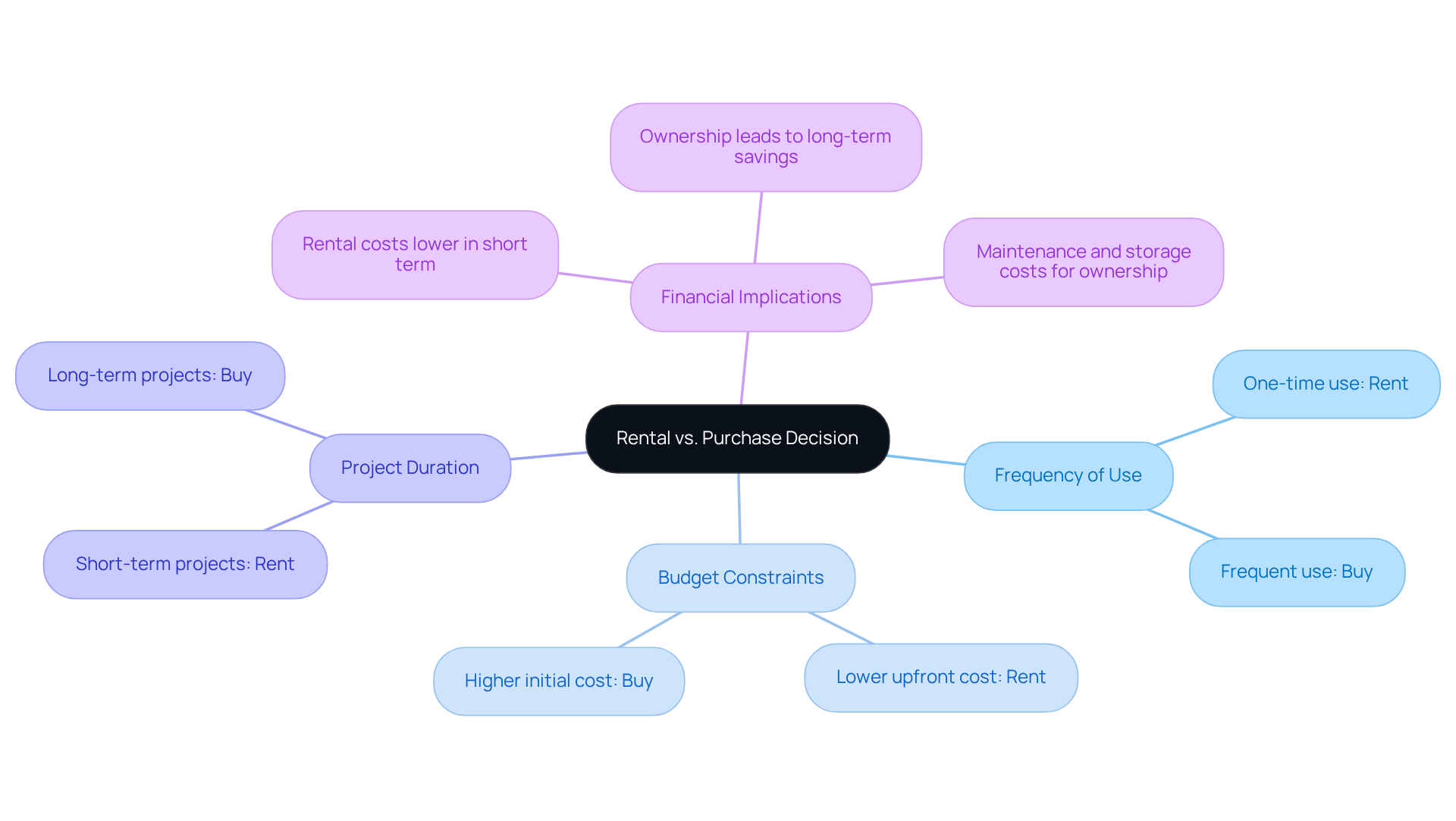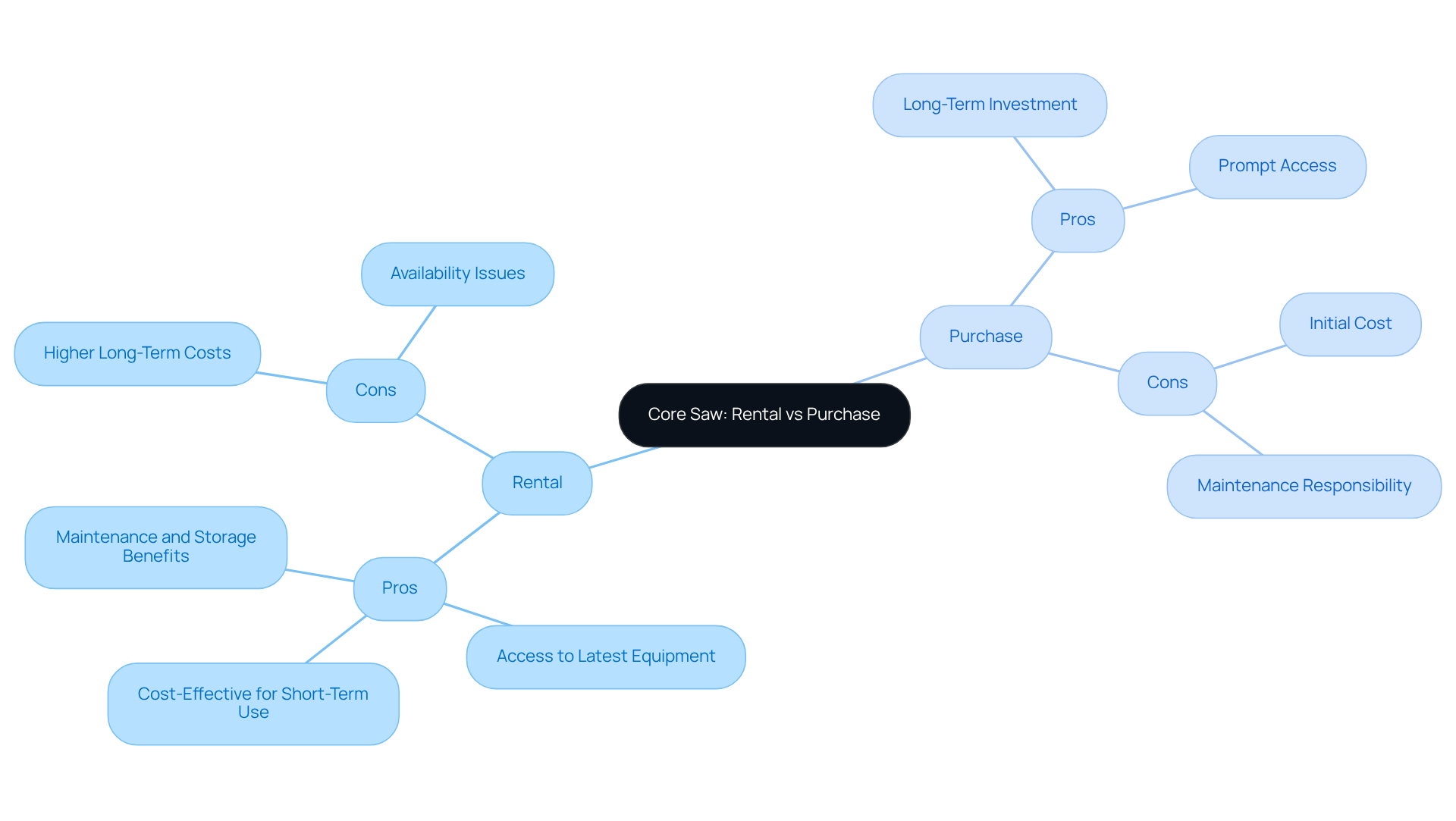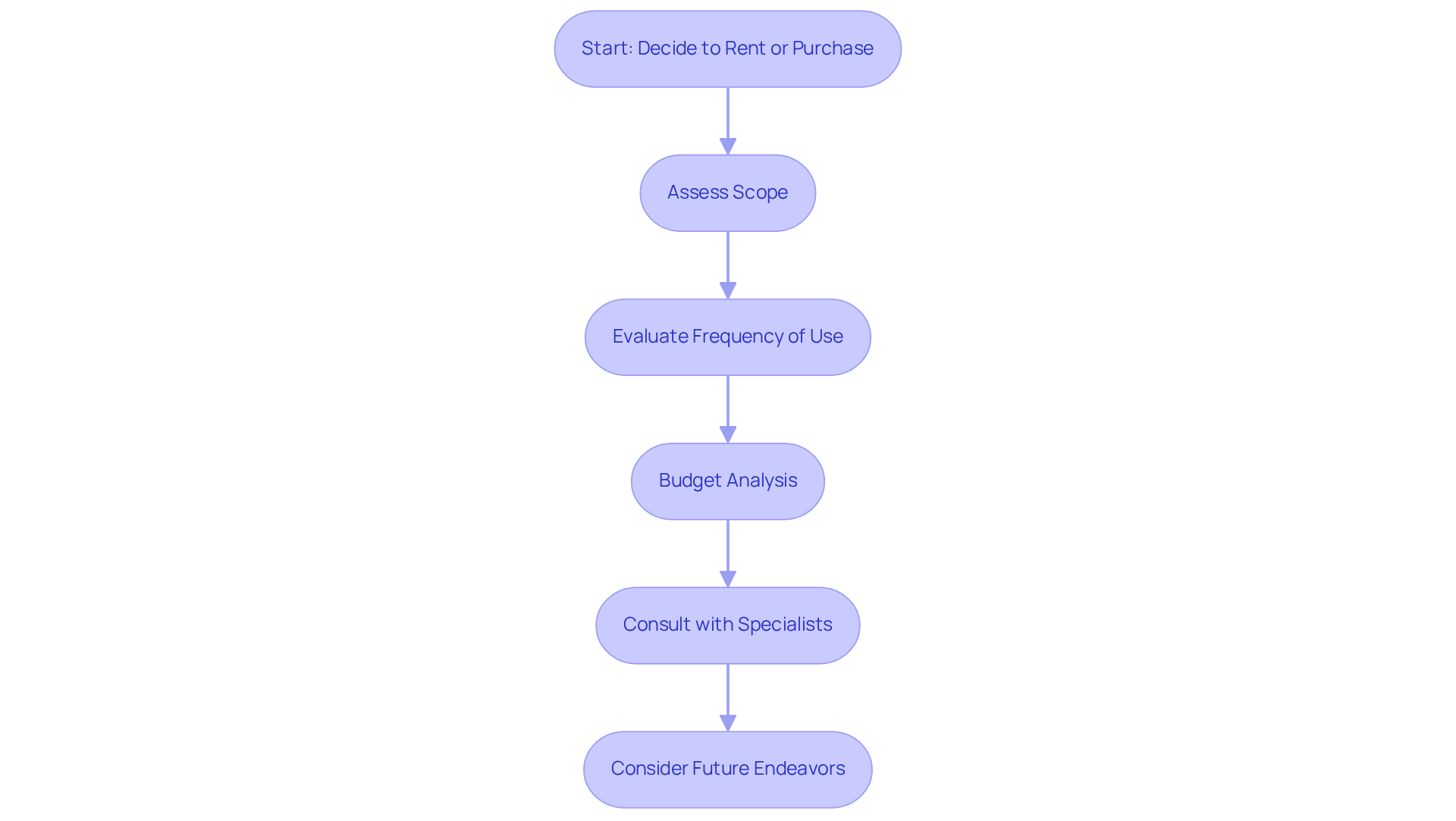Overview
The article addresses the critical considerations in deciding whether to rent or purchase a core saw for construction projects. Key factors such as frequency of use, budget, and project duration play a significant role in this decision-making process. Notably, renting often proves to be more cost-effective for short-term needs, thanks to lower upfront costs and included maintenance support. In contrast, purchasing a core saw can be advantageous for long-term use, despite the higher initial expenses. This is underscored by the statistic that 74.5% of construction companies opted for rentals in the past year, highlighting a prevailing trend in the industry.
Key Highlights:
- Core saws are precision tools used for creating accurate holes in materials like concrete and asphalt, vital for construction tasks such as plumbing and electrical work.
- Over 60% of construction projects utilise core saws, highlighting their importance in the industry.
- Recent advancements in core saw technology have improved efficiency and versatility, making them essential for various applications including roadwork and renovations.
- When deciding between renting or purchasing a core saw, factors such as frequency of use, budget constraints, and project duration must be considered.
- Renting a core saw is cost-effective for short-term use, provides access to the latest equipment, and includes maintenance, while the purchase is more economical for long-term use despite higher upfront costs.
- 74.5% of construction companies reported using core saw rentals in the past year, indicating a trend towards renting over purchasing.
- Pros of renting include lower initial costs and maintenance support, while cons include potentially higher long-term costs and availability issues during peak rental seasons.
- Purchasing a core saw offers long-term investment benefits and immediate access, but involves higher initial costs and maintenance responsibilities.
- To make an informed decision, assess project scope, evaluate frequency of use, analyse budget, consult with specialists, and consider future project needs.
Introduction
Core saws stand as indispensable tools within the construction industry, renowned for their precision in creating holes in resilient materials such as concrete and asphalt. As projects increasingly demand heightened accuracy and efficiency, the decision to rent or purchase these essential tools becomes a pivotal consideration for project managers.
However, the choice is not as straightforward as it may appear, given the fluctuating costs, varying project timelines, and the necessity for immediate access to equipment.
What factors must be weighed to ensure that the right decision aligns seamlessly with both budget constraints and project requirements?
Understanding Core Saws: Functionality and Applications
Core cutters are precision-engineered tools that are essential for creating accurate holes in materials such as concrete, asphalt, and masonry. Their primary applications in construction encompass plumbing installations, electrical work, and HVAC system setups. The design of these critical cutting tools allows for precise cuts, minimizing damage to adjacent materials, which is vital for both structural integrity and aesthetic considerations. Recent advancements in core saw technology have significantly enhanced their efficiency and versatility; indeed, over 60% of construction projects now utilize core saws for plumbing and electrical tasks. As civil engineer Robert Taylor aptly notes, 'Quality tools are essential for attaining accuracy in construction endeavors.' Furthermore, these tools play a crucial role in roadwork, utility installations, and renovation projects, where precision is paramount.
Understanding the various capabilities of core cutting tools enables project managers to make informed decisions regarding core saw rental or equipment purchase based on specific project requirements and timelines. For instance, a case study on HVAC installations demonstrated how circular blades facilitated the seamless integration of systems while preserving the quality of the surrounding structure. However, it is imperative to consider the hazards associated with core drilling, such as inhaling silica dust and elevated noise levels, which can pose health and safety risks. Therefore, a comprehensive understanding of core saws, including their advantages and disadvantages, is essential for the effective management of construction projects.

Evaluating Rental vs. Purchase: Key Considerations
When evaluating the decision to opt for a core saw rental or to buy a main saw, several essential factors must be considered. The frequency of use is paramount; for a one-time task, a core saw rental is typically the most economical choice. Conversely, if the core saw will be employed consistently across various tasks, purchasing it may prove more cost-effective over time. Budget constraints also significantly influence this decision-making process. Renting a core saw generally necessitates a lower upfront investment, making it an appealing option for short-term needs, while buying entails a higher initial cost but can lead to long-term savings if the equipment is utilized frequently.
Moreover, the duration of the project is critical. Short-term initiatives often benefit from rental agreements that offer flexibility and reduce financial risk, whereas long-term projects may warrant the investment in ownership. A financial analysis of core saw rental versus buying in 2025 reveals that while rental costs can fluctuate, they usually remain lower than the cumulative expenses associated with ownership, particularly when maintenance and storage are taken into account. Notably, 74.5% of construction companies reported core saw rental within the past year, underscoring the prevalence of this option in the industry.
Case studies illustrate that businesses frequently opt for rentals to manage cash flow effectively, allowing capital to be allocated to other vital areas. For instance, the analysis on 'Renting vs. Buying Equipment' demonstrates how companies have thrived by choosing rentals for short-term requirements. Financial analysts emphasize that understanding these dynamics is essential for making informed decisions that align with both objectives and budgets. Furthermore, insights from Lithko Contracting highlight the necessity of comprehending the costs associated with owning versus renting equipment. Ultimately, a thorough evaluation of usage patterns, timelines, and financial implications will empower construction managers to select the most suitable core saw rental option for their primary saw needs.

Pros and Cons of Core Saw Rental and Purchase
Pros and Cons of Core Saw Rental and Purchase
Pros of Core Saw Rental:
- Cost-Effective for Short-Term Use: Renting a core saw eliminates the need for a significant upfront investment, making it an ideal choice for one-off projects. This flexibility allows construction managers to allocate funds more efficiently.
- Access to Latest Equipment: Rental companies frequently update their inventory, providing access to the latest models equipped with advanced technology and features that enhance performance and efficiency.
- Maintenance and Storage Benefits: Rental agreements typically include maintenance services, relieving users of the burden of upkeep. Furthermore, there’s no requirement for specific storage when the tools are not in use, which can be a considerable benefit in handling logistics for the initiative. For example, businesses that lease tools frequently mention lower overhead expenses linked to storage and upkeep.
Cons of Core Saw Rental:
- Higher Long-Term Costs: For projects requiring extended use of a core saw, rental costs can accumulate quickly, potentially surpassing the purchase price. This is especially pertinent in the context of ongoing construction initiatives where machinery is required over several months. According to market research, the power equipment rental market is projected to grow at a CAGR of 5.3% from 2023 to 2033, indicating increasing demand that could affect rental prices.
- Availability Issues: During peak rental seasons, the demand for core saw rental can spike, leading to potential delays in timelines. This can hinder productivity and affect overall timelines, making it essential to plan in advance. Statistics indicate that availability issues can result in delays of up to 20%, highlighting the significance of early planning.
Pros of Core Saw Purchase:
- Long-Term Investment: Purchasing a core saw can be more economical over time, especially for companies that frequently undertake projects requiring this equipment. Ownership allows for better budgeting and cost management in the long run.
- Prompt Access: Having a primary saw guarantees it is consistently accessible when required, removing the risk of rental holdups that can interfere with schedules.
Cons of Core Saw Purchase:
- Initial Cost: The upfront cost of purchasing a core saw can be substantial, which may strain budgets, particularly for smaller projects or companies with limited financial resources.
- Maintenance Responsibility: Equipment owners are responsible for all maintenance, repairs, and storage, which can add to overall costs and require additional management resources. This responsibility can be a significant factor for managers balancing multiple tasks.
In summary, the choice between renting and buying a saw depends on the length of the task, budget limitations, and the necessity for prompt access to equipment. Comprehending these factors, alongside the current market trends and expert insights, can assist construction managers in making informed decisions that align with their objectives.

Making the Right Choice: Rental or Purchase for Your Project
To determine whether to rent or purchase a core saw for your construction project, follow these essential steps:
-
Assess Scope: Begin by evaluating the size and duration of your endeavor. For short-term tasks, a core saw rental often proves to be more advantageous, providing flexibility without the burden of ownership.
-
Evaluate Frequency of Use: Consider how often you will need the core saw. If several initiatives are upcoming that necessitate this apparatus, considering a core saw rental might be a more cost-effective option in the long term, as it removes recurring rental expenses.
-
Budget Analysis: Conduct a thorough analysis of your budget. Determine if you can accommodate the upfront costs associated with purchasing or if a core saw rental is a better option given your financial constraints. Remember, renting is classified as an operational expense, while ownership involves capital tied up in assets. Importantly, core saw rental usually incurs expenses 2 to 4 times more than purchasing the tools, which is a considerable factor for managers overseeing tasks.
-
Consult with Specialists: Communicate with rental authorities or management professionals. Their insights can offer customized guidance based on your particular requirements and assist you in managing the intricacies of decision-making regarding core saw rental options. As Chris Doyle, CEO & Founder of Billd, observes, "Before deciding whether to buy or lease tools as a construction entrepreneur, it’s crucial to evaluate the total expenses related to ownership, along with the advantages, and compare this against the pros and cons of leasing."
-
Consider Future Endeavors: If you foresee ongoing tasks that will necessitate a core saw rental, it may be more beneficial to invest in a purchase, yielding long-term advantages such as potential tax deductions and the elimination of rental fees. Additionally, owning equipment means you are responsible for maintenance and repairs, which is a critical factor to consider when evaluating your options.
By following these steps, you can make a well-informed decision that aligns with your project goals and financial capabilities, ensuring that you choose the most effective solution for your construction needs.

Conclusion
In evaluating the options between core saw rental and purchase for construction projects, the significance of making an informed decision cannot be overstated. It is essential for project managers to comprehend the functionality and applications of core saws, as this understanding directly influences their assessment of specific needs, budget constraints, and project duration. The ultimate choice hinges on whether the immediate flexibility of rental or the long-term investment of ownership better aligns with the project's requirements.
Key insights reveal that renting a core saw can serve as a cost-effective solution for short-term tasks. This option provides access to the latest technology without the burdens of maintenance and storage. Conversely, purchasing a core saw may yield long-term savings for frequent users, ensuring immediate availability and potentially lower overall costs when used consistently. An analysis of various factors—including usage frequency, budget implications, and project duration—serves as a guide for construction managers navigating this decision-making process.
Ultimately, the decision to rent or purchase a core saw requires careful consideration of all relevant factors. By evaluating project scope, consulting with experts, and analyzing financial implications, construction professionals can make choices that enhance operational efficiency and align with strategic objectives. Embracing the right approach to core saw rental or purchase can significantly impact project success, ensuring effective resource utilization and seamless achievement of goals.
Frequently Asked Questions
What are core saws used for?
Core saws are precision-engineered tools used for creating accurate holes in materials such as concrete, asphalt, and masonry. Their primary applications include plumbing installations, electrical work, and HVAC system setups.
What advantages do core saws offer in construction?
Core saws allow for precise cuts, minimizing damage to adjacent materials, which is vital for maintaining structural integrity and aesthetic considerations. They enhance efficiency and versatility in various construction projects.
How prevalent are core saws in construction projects?
Over 60% of construction projects now utilize core saws for plumbing and electrical tasks, highlighting their importance in the industry.
What role do core saws play in specific projects?
Core saws are crucial in roadwork, utility installations, and renovation projects, where precision is essential for successful outcomes.
What should project managers consider when using core saws?
Project managers should understand the capabilities of core cutting tools to make informed decisions regarding core saw rental or equipment purchase based on specific project requirements and timelines.
What are some health and safety risks associated with core drilling?
Hazards associated with core drilling include inhaling silica dust and elevated noise levels, which can pose health and safety risks to workers.
Why is it important to understand the advantages and disadvantages of core saws?
A comprehensive understanding of core saws, including their benefits and potential risks, is essential for the effective management of construction projects.




